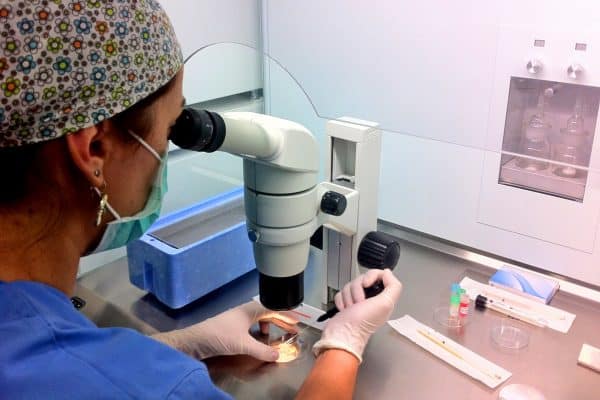Gestational surrogacy is a reproductive technology where embryos are produced ‘in-vitro’ in a laboratory and subsequently implanted into the uterus of a woman – the gestational surrogate or surrogate mother – who has agreed to carry the child to term and hand it over to the commissioning ‘intended parents’ after its birth. This is in contrast to so-called ‘traditional surrogacy’ which does not necessarily require the use of reproductive technologies because it uses the surrogate’s own egg cells that are fertilized through sexual intercourse or medically performed insemination.
While traditional surrogacy has a long history (examples can already be found in the Bible (Genesis 10 and 16), gestational surrogacy has only become possible with the development of in-vitro fertilization technology where egg cells are fertilized and incubated outside the body in a laboratory and the embryos subsequently implanted into a woman’s uterus. What makes commercial (that is, paid) gestational surrogacy so special and also subject to wide criticism is that the surrogate mother is neither related to the embryo, since the egg cell comes from the future social mother or a donor, nor intends to keep the baby but agrees to give it away in exchange for money.
On local and many national levels, surrogacy is a highly contested reproductive technology regarding moral regimes, political contexts and legal conditions. At the same time, it is also dependent on and takes place in transnational networks within which technologies, gametes, people, money, knowledge, and information circulate. Both local conditions and transnational networks of surrogacy influence and in some respects also generate one another. However, while connectivity between different locations and people is created through mobility and the travel of things, knowledge and persons – ideally resulting in the birth of a child – the very same process is also marked by friction and discrepancies: some countries’ legal restrictions are capitalized on by other countries’ support or acceptance of the surrogacy industry; the wealth of intended parents intersects with the poverty of the surrogate mothers in certain other countries (such as India); what is medically possible (especially in the field of preimplantation genetic diagnosis) may be antithetical to ethical concerns and public discourses in the intended parents’ home country, etc. The intersection of the local and global conditions of surrogacy and the connections and frictions that emerge in this context are the subject of this blog piece. But in contrast to many critics of surrogacy, I argue that a legal permission of surrogacy would contribute to the protection of surrogates and a better quality of medical and other services.
In my opinion, it is the ban of surrogacy that opens a space for unethical practices and the incapacitation of surrogates.
Local Discourses and Legal Conditions in Germany and Switzerland
In both countries, the public is highly critical of surrogacy and the practice is regarded in primarily negative ways. Critics refer to the dangers and effects of the technologies involved, especially when it comes to the use of donor gametes and preimplantation genetic diagnosis (PGD) both of which are suspected to contribute to the creation of so-called ‘designer babies’ – babies that in every respect are artificially designed according to their parents’ wishes. Another camp of critics focuses on the exploitation of women, particularly surrogates and egg donors, who are understood as compelled to sell their bodies and reproductive capacities due to financial distress. There are also critics who see a surrogate pregnancy as something ‘unnatural’ and problematize the separation of the bond between the surrogate and the child after it has been handed over to the intended parents. In their opinion, people who suffer from infertility (or constellations of intended parents such as gay couples or single parents) should accept their fate and either adopt a child or remain childless. And finally, surrogacy is often presented as a form of ‘baby-selling’. It is argued that surrogacy poses a great threat to the idea that children are “precious yet priceless” (Berend 2015). There are many more points of criticism, but these four issues are at the center of public discourses and frequently overlap. Moreover, these criticisms have a strong moral connotation: Parallels are drawn with the Nazi era (euthanasia and the creation of a ‘superrace’), colonialism and (sex) slavery.
Surrogacy is perceived as a threat to traditional family values and institutions, and as immeasurably capitalistic.
This moral regime is mirrored in the respective political approaches to surrogacy and the legal regulations that are derived from them. It is true that some individual politicians argue in favour of the practice. For example, Ulrike Flach from the Liberal Democratic Party in Germany has suggested that surrogacy should be legally permitted, albeit only in its unpaid, ‘altruistic’ form (Bubrowski 2013). However, the majority of politicians from all party backgrounds in both Germany and Switzerland strongly reject the practice. One example from Germany is Hubert Hüppe, a Member of Parliament from the conservative Christian Democratic Party whose work focuses on bioethics and disability. He argues that surrogacy is a form of human trafficking, criticizes the commodification of children, and maintains that due to the medical procedures that are often involved (e.g., Preimplantation Genetic Diagnosis, abortions in case of disability, etc.) it also discriminates against people with disabilities (Hüppe 2014). Interestingly, at the other end of the political spectrum, the Left Party equally condemns surrogacy. For example, the queer working group of the Left Party rejects surrogacy on the basis that it is against the Embryo Protection Act (Die Linke queer Hamburg 2012). All in all, there is a clear consensus among the majority of politicians in both countries not to abolish the current prohibition of surrogacy.
Consequently, both the moral regimes and political conditions in these two countries inform their laws on reproductive technologies which are amongst the most restrictive worldwide. They do not permit ova donation, the creation and subsequent implantation of an embryo into a woman who is genetically not related to the embryo[1] (i.e. who is not the person from whom the egg cell has been taken), or the initiation of a pregnancy in a woman who does not intend to keep the baby but carries it for others. Moreover, the brokering of surrogacy by agencies is equally prohibited. Medical professionals risk losing their licences if they perform these procedures and, like agencies, may be subjected to high monetary fines and possibly even imprisonment. Since many gestational surrogacies involve ova donations and all require in-vitro fertilization with the goal of implanting the embryo into another woman, and since advertising or using an agency to find a surrogate is a necessary step in the process of commissioning a surrogacy, the procedure is not performed in Germany and Switzerland. However, neither commissioning a surrogacy, nor acting as a gestational surrogate, are punishable. Many of my German informants used the word ‘schizophrenic’ when referring to the prohibition of surrogacy since the country suffers from very low birth rates and the current political approach to reproduction is generally pronatalist.

Transnational Reproductive Travel and Segregation on the Basis of Financial Resources
Both in Germany and Switzerland the legal restrictions regarding assisted reproductive technologies have led many people to travel abroad for reproductive treatment. In medical anthropology and neighbouring disciplines there has been some discussion about the terminology describing this process. While ‘reproductive tourism’ is a term that is still commonly used (e.g., Bergmann 2011, Deomampo 2013, Pennings 2004), it has been increasingly criticized for its negative connotations and insinuation of pleasure. Some researchers have suggested using ‘cross-border reproductive travel’, ‘reproductive travel’ or ‘cross-border reproductive care’ (e.g., Inhorn and Gürtin 2011, Shenfield et al. 2010, Whittaker and Speier 2010) instead. I have chosen to use the term ‘reproductive travel’ as it does not imply the enjoyment that is connoted by ‘tourism’.
However, in contrast to ‘cross-border reproductive care’, it emphasizes the mobility – the topic of this thematic week – that characterizes transnational surrogacy.
Against the background of transnationally diverging legal and ethical-moral frameworks as well as greatly differing costs, certain geographic places tend to become the locations of certain medical specialties (Andrade Neves 2016; Kangas 2002). This can also be said about surrogacy. Countries such as Ukraine, India (although this is currently changing)[2], and some US-American states not only permit surrogacy but in some ways facilitate the performance of this practice, which has led to the emergence of an industry sector generating billions of dollars every year (Spar estimates the amount of money paid for surrogacy in the United States in 2004 at approximately US$ 27.400.000 (2006: 3), a number which, due to the expansion of the surrogacy industry in the last few years, is likely to be even higher today). In these specialized locations, agencies, clinics, and related businesses thrive and advertise widely to attract more prospective customers. Medical specialization, related services (such as agencies lawyers), and the geographic location of the surrogacy business sector thus merge at these ‘reproductive hubs’.

However, traveling to these hubs is not open to everyone and financial resources further determine which destinations are affordable to whom (Roberts 2011). While a surrogacy in the United States is likely to cost around US$ 150.000, in countries such as India, Ukraine or Mexico it can be commissioned for a fraction of that amount (e.g., an aggressively advertising fertility clinic in Ukraine – BioTexCom – offers an ‘Economy Package’ for surrogacy for € 29.900). But these differences in pricing also mirror differences in many other aspects, ranging from the quality of medical services to the quality of agency services, the reasons why surrogates decide to carry a child for someone else, anonymity versus so-called open programmes, where surrogates and intended parents meet and get to know one another, and so on. All intended parents I spoke to in my project showed great interest in these issues, and especially the wellbeing of the surrogate. However, especially when financial constraints play a role, financial considerations may prevail at the expense of considerations concerning issues of quality and care.
But perhaps the most important factor for many intended parents is how easily they will be able to take the child home with them. This depends on the country’s laws concerning the definition of parenthood and the acquisition of citizenship which determine how easily a child can receive a birth certificate, visa, and passport which are necessary for cross-border travel back to the intended parents’ home country. While it is fairly easy to obtain the necessary documents for a child born through surrogacy in the United States, this is not always the case in India or Ukraine. One of the participants in my research had to remain in India for one and a half years due to the fact that the German consulate refused to provide him with the necessary documents for his child born through surrogacy in India. According to him, there is an entire community of foreign intended parents in India who face the same problem. While usually one of the parents returns home to keep earning money, the other looks after the child in India and tries to get hold of the appropriate documents for cross-border travel. In contrast to this situation, every person born on US territory automatically receives US citizenship (jus soli) and with a US passport can travel to Europe without a visa. The segregation of intended parents based on financial resources thus not only has effects on where they can commission a surrogacy, but it also influences how easily they can return home with their child.
Transnational Networks of Persons, Things, Knowledge, and Communication
These reproductive hubs are the sites where all the actors involved in a surrogacy come together: the intended parents who in the case of this research have travelled there from abroad, the surrogates, who carry their babies, the agencies and their personnel, many of whom have in the past either been intended parents or surrogates themselves. Moreover, many surrogacies involve egg and sperm donors and their gametes that, in cryopreserved form, may have travelled across the country or even across national borders. The whole process is usually regulated in a contract that is prepared and written out by lawyers. The medical procedures such as health check-ups, hormonal treatment, the surgical removal of ova, and the implantation of embryos into the surrogate’s uterus are performed by doctors and supported by nurses. In addition, lab personnel and embryologists prepare sperm, perform in-vitro fertilization or intracytoplasmic sperm injection, breed embryos in incubators, and carry out preimplantation genetic diagnosis. Also, gametes and embryos are cryopreserved in cryobanks. Moreover, knowledge concentrates at and travels to and from these reproductive hubs, for example when new procedures with higher success rates are developed. Finally, fertility clinics make important investments in technological equipment, medical and otherwise (such as high-end air filter system for laboratories and operating theaters).

In addition to these networks of persons, things, and knowledge, the internet, too, is an integral element of surrogacy.
Without the internet, surrogacy would not exist in its current form. Interestingly, for different surrogacy actors it serves quite different purposes. For agencies and clinics, it is first and foremost a medium through which they can advertise their services worldwide. For intended parents, especially at the beginning of the usually long process that finally leads them to decide to commission a surrogacy, it is mainly a place where they can find out about surrogacy – both from the official websites of agencies providing surrogacy services and in online discussion forums where information is exchanged between people who are in a similar situation.
As my research showed, these online discussion forums are the most important source of information for intended parents from countries that prohibit surrogacy. As they cannot seek advice in family planning clinics because even the reference to clinics providing egg donations and surrogacy may cause legal problems for German or Swiss doctors, intended parents are strongly dependent on the advice of others who have already undergone the procedure – both medically and legally (e.g., with regard to documents and citizenship). In these forums, which are usually closed to outsiders and have very strict membership rules in order to prevent journalists or possibly also officials from exploring who is involved and what is discussed, information is exchanged concerning good doctors, clinics, and agencies (some of which explicitly cater to German-speaking customers by employing German-speaking staff), which lawyers specialize in surrogacy contracts, which pharmacies from abroad send hormone injections and other medications necessary for preparing the retrieval of egg cells, etc. Many intended parents acquire almost all their information from such fora, and a number of long-term members, whose surrogacy dates several years back, volunteer not just information but also emotional support in a situation many intended parents experience as very straining.
Similarly, gamete donors and surrogates in many cases find out about the options of donating or becoming a surrogate on the internet (Almeling 2011), although this does not necessarily apply to women in countries like India where illiteracy is widespread. But those who use the internet access information on websites operated by agencies or sperm and egg banks, and in addition also often become members of online discussion forums and support groups (Berend 2016). In some places, such as Israel, where surrogacy is legal, some support groups cater to the needs of intended parents and surrogates together (Teman 2010). Finally, gamete donors and surrogates may also use the internet to introduce themselves. Many agencies and sperm and egg banks provide online catalogues of donors with photos, sometimes sound samples of their voice, and information about their private and professional background. These catalogues, however, are usually only accessible to registered users who receive the access data from their agency or sperm/egg bank.
When a surrogate is pregnant, most of the communication between intended parents, the surrogate, agency personnel, and sometimes doctors, also takes place on the internet. In contrast to surrogacies where the different actors live in geographical proximity to one another and can regularly meet in person (as Teman (2010) describes for the case of Israel), cross-border reproductive travel is characterized by geographical distance between the different actors. Intended parents and surrogates seem to often use forms of communication such as Skype or Facetime as a way to meet ‘face-to-face’ in addition to regular email contact. Research participants recounted that they were able to join important doctor’s appointments with their surrogate via Skype or Facetime.
Interestingly, although place can be overcome in a certain sense via the internet, time continues to pose a problem in these transnational encounters.
Research participants complained that they had to get up in the middle of the night in order to be able to skype with their surrogate or be present via Skype at one of her appointments, or that there were regular misunderstandings regarding the time difference so that a Skype conversation could not take place as planned, and so on.
The Transnational Embryo
As I have shown, the local conditions in Germany and Switzerland make it impossible for intended parents from these countries to commission a surrogacy at home. As a result, they go abroad in order to gain access to medical services they would not be able to access otherwise. Typically, they travel to what I have called ‘reproductive hubs’ of surrogacy – places where persons, technology, knowledge, communication, and money concentrate in order to create babies.
The embryo that comes into being in this way is transnational itself and embedded into global networks of reproduction.
However, these global networks are double-faced – they have a strongly connecting quality, but they also emerge as a result of global inequalities and power differences. The strict ban on surrogacy in some countries seems to enforce rather than mitigate these global inequalities by outsourcing the practice into other (especially low-cost) countries where legal protection of neither surrogates nor intended parents is granted. I suggest that these inequalities and power differences are enforced rather than mitigated by strict bans of surrogacy. Legal regulations permitting surrogacy are likely to empower surrogates by giving them a legal basis and ways to enforce their rights, while intended parents would be able to find legitimate clinics and agencies.
Co-published by Allegra Lab and the Collaborative Blog Medizinethnologie: Body, Health and Healing in an Interconnected World
References
Almeling, Rene. 2011. Sex Cells: The Medical Market for Eggs and Sperm. Berkeley: University of California Press.
Andrade Neves, Marcos. 2016. Living Within Assisted Suicide: Drawing a Landscape and its Transnational Movements. Blog Medizinethnologie: Körper, Gesundheit und Heilung in einer globalisierten Welt. Last access: 02.11.2016
Berend, Zsuzsa. 2015. Misconceptions About Altruism and Choice in US Surrogacy. openDemocracy. Last access: 15.12.2015
—. 2016. The Online World of Surrogacy. New York, Oxford: Berghahn.
Bergmann, Sven. 2011. Fertility Tourism: Circumventive Routes That Enable Access to Reproductive Technologies and Substances. In: Signs 36(2), 280-289.
Bubrowski, Helene. 2013. Deutsche Behörden unterlaufen Verbot der Leihmutterschaft. In Frankfurter Allgemeine Zeitung. Frankfurt.
Deomampo, Daisy. 2013. Gendered Geographies of Reproductive Tourism. In: Gender & Society 27(4), 514-537.
Die Linke.queer Hamburg. 2012. Fragen zum Thema “Homosexualität“. Last access: 02.11.2016
Hüppe, Hubert. 2014. Bezahlte Leihmutterschaft ist Menschenhandel. Last access: 02.11.2016
Inhorn, Marcia C. and Gürtin, Zeynep B. 2011. Cross-Border Reproductive Care: A Future Research Agenda. In: Reproductive BioMedicine Online 23, 665-676.
Kangas, Beth. 2002. Therapeutic Itineraries in a Global World: Yemenis and the Search for Biomedical Treatment Abroad. In: Medical Anthropology 21 (1), 35-78.
Marcus, George E. 1995. Ethnography in/of the World System: The Emergence of Multi-Sited Ethnography. In: Annual Review of Anthropology 24, 95-117.
Pennings, Guido. 2004. Legal Harmonization and Reproductive Tourism in Europe. In: Human Reproduction 19(12), 2689–2694.
Roberts, Elizabeth F.S., and Nancy Scheper-Hughes. 2011. Introduction: Medical Migrations. In: Body & Society 17 (2& 3), 1-30.
Shenfield, F., de Mouzon, J., Pennigs, G., Ferraretti, A. P., Nyboe Andersen, A., de Wert, G., Goossens, V. and the ESHRE Taskforce on Cross Border Reproductive Care. 2010. Cross Border Reproductive Care in Six European Countries. Human Reproduction 25(6), 1361-1368.
Spar, Debora L. 2006. The Baby Business: How Money, Science, and Politics Drive the Commerce of Conception. Boston: Harvard Business School Press.
Teman, Elly. 2010. Birthing a Mother: The Surrogate Body and the Pregnant Self. Berkeley: University of California Press.
Whittaker, Andrea and Speier, Amy. 2010. “Cycling Overseas”: Care, Commodification, and Stratification in Cross-Border Reproductive Travel. Medical Anthropology 29(4), 363-383.
[1] However, embryo donation is not covered by the German Embryo Protection Act (Embryonenschutzgesetz) and thus not strictly prohibited.
[2] The Indian government is currently planning to enforce a complete ban of surrogacy for foreigners.





